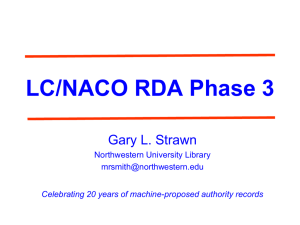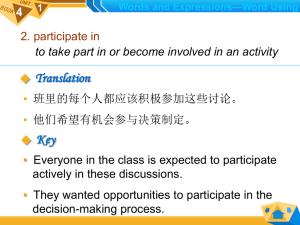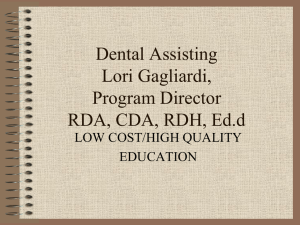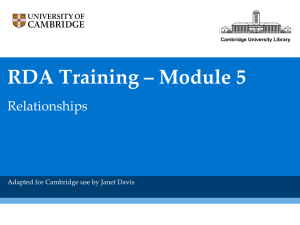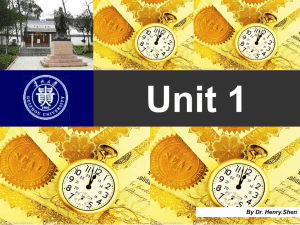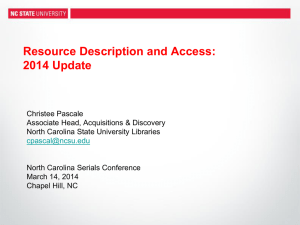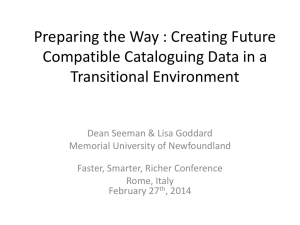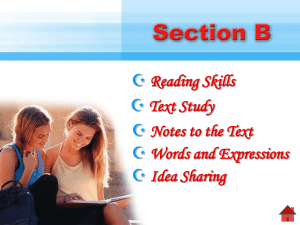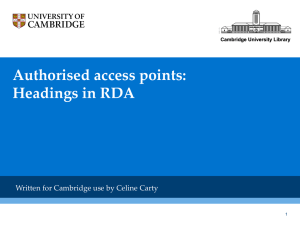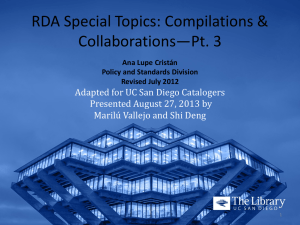RDA Module 4 presentation
advertisement
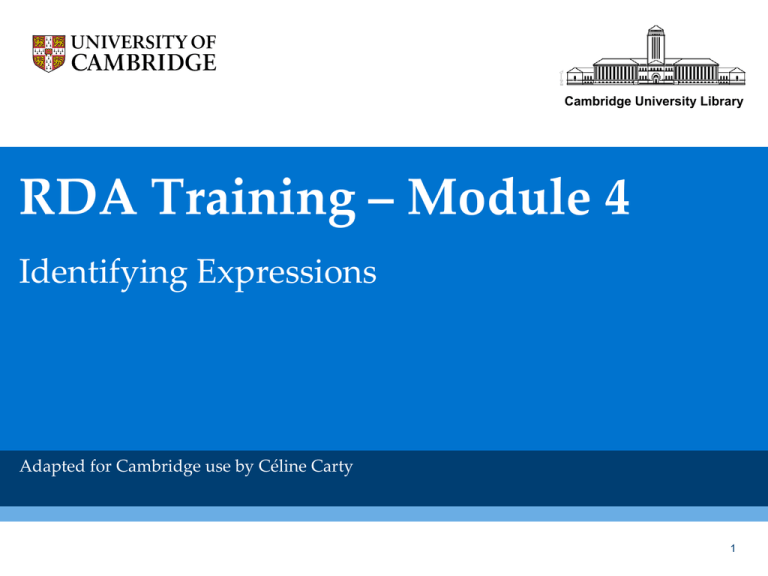
Cambridge University Library RDA Training – Module 4 Identifying Expressions Adapted for Cambridge use by Céline Carty 1 Acknowledgements This module, and the accompanying four, are based on the training given at the British Library, which is in turn developed from that used at the Library of Congress. We would like to express our thanks to both institutions for making their training materials available to us. 2 Identifying expressions “Expression” – the FRBR Entity Identifying the expression Authorised access points representing expressions Additions to authorised access points for expressions Contributors Describing content 3 Expression – the FRBR entity The way in which a work (the idea in the creator’s mind) is expressed through … • • • • Language Sound Movement Performance … etc. 4 Identifying the expression The instructions for identifying expressions, like for works, are in Chapter 6 1) Name the work 2) Add expression-level identifying information 100 1# $a Shakespeare, William, $d 1564– 1616, $e author. 240 10 $a Hamlet. $l French 5 When to identify expressions Authorised access points are used in bibliographic records to identify the expression being catalogued; also in 6XX and 7XX to represent relationships to other expressions Identify expressions for these types of resource by adding an attribute to the authorised access point • • • • Translations and language editions (6.27.3) Abridgements (6.2.2.10.2) Music resources (6.28.3) Sacred scriptures (6.30.3) 6 Identifying the expression - Examples 100 1# $a Zola, Émile, $d 1840-1902, $e author. 240 10 $a Germinal. $l English 100 1# $a Graham, Kenneth, $d 1859-1932, $e author. 240 10 $a Wind in the willows. $s Abridgement 100 1# $a Sullivan, Arthur, $d 1842–1900, $e composer. 240 10 $a Mikado. $o Chorus score 130 0# $a Bible. $l Latin. $s Vulgate. $f 1454. 7 How else to identify expressions For expressions in other categories, Cambridge will include the expression attributes in other fields in the bibliographic record: 264 field - Date of expression - often the date of manifestation is used 336 field - Content type 8 Decisions on … how to identify expressions Generally do not add more than one characteristic to differentiate an expression from another expression • e.g., do not differentiate one translation of Hamlet in French from another French translation of the same work • e.g., do not differentiate one abridgement of Homer’s Iliad from another abridgement of the same work Exception: may differentiate expressions of the same sacred scripture if necessary Note that this policy may change in future when FRBR is more fully implemented. 9 Constructing the authorised access point representing an expression RDA 6.27.3 The basis is the authorised access point for the work Make additions as outlined in 6.27.3b 100 1# $a Goncourt, Edmond de, $d 1822–1896, $e author. 240 10 $a Frères Zemganno. $l English 10 Additions to authorised access points representing expressions • Content type (6.9) • Date of the expression (6.10) • Language of the expression (6.11) • Another distinguishing characteristic of the expression (6.12) Only if needed to differentiate No priority order 11 Additions – Content type CORE ELEMENT when needed to differentiate RDA 6.9 “fundamental form of communication in which the content is expressed and the human sense through which it is intended to be perceived ...” Controlled vocabulary in RDA 6.9.1.3 Recorded in subfield $h of the access point 130 0# $a Bible. $p Gospels. $l English. $s New Millenium. $h Spoken word. $f 2002. [For the audiobook of a printed text] 12 Additions – Date of expression CORE ELEMENT when needed to differentiate RDA 6.10 The earliest date associated with an expression – may use date of earliest manifestation embodying the expression Take from any source Year(s) alone Recorded in subfield $f of the access point 130 0# $a Koran. $l German. $f 2000. 13 Additions – Language of expression CORE ELEMENT when needed to differentiate RDA 6.11 Take from any source Use term(s) from the MARC 21 list of languages Record in subfield $l of the access point (not repeatable) Distinguish between: • one expression in more than one language • two or more expressions 14 Language - if one expression … Work expressed in one language • give $l only if a translation 100 1# $a Brunhoff, Jean de, $d 1899-1937. 240 10 $a Babar en famille. $l English 245 10 $a Babar and his children. Work expressed in more than one language • do not give $l unless a translation 100 1# $a Tolstoy, Leo, graf, $d 1828-1910. 245 10 $a Voĭ na i mir. 15 Language – if two expressions … If the manifestation is a compilation of the original and one translation of the same work (parallel text) • record an analytical authorised access point for the original expression (without $l for the language) • record a separate analytical authorised access point for the translation (with $l for the language) 16 Two expressions Original and one translation Original + Spanish translation in same resource : AACR 041 100 240 245 1# 1# 10 10 $a eng $a spa $h eng $a Macken, JoAnn Early, $d 1953$a Mail carrier. $l Spanish & English $a Mail carrier = $b El cartero / $c JoAnn Early Macken. 246 31 $a Cartero 546 ## $a Text in English with parallel translation in Spanish. 17 Two expressions Original and one translation Original + Spanish translation in same resource : RDA 041 1# $a eng $a spa $h eng 100 1# $a Macken, JoAnn Early, $d 1953245 10 $a Mail carrier = $b El cartero / $c JoAnn Early Macken. 246 31 $a Cartero 546 ## $a Text in English with parallel translation in Spanish. 700 12 $a Macken, JoAnn Early, $d 1953$t Mail carrier. 700 12 $a Macken, JoAnn Early, $d 1953$t Mail carrier. $l Spanish. 18 If more than two expressions … If the compilation contains the original expression and more than one translation • Record an authorised access point for the original expression (without $l for the language) • Record an authorised access point for at least one translation (with $l for the language) Cambridge policy: Give all additional analytical access points unless unduly onerous 19 Three expressions – Original and two translations Original + English + Hindi translations in same resource: RDA 100 1 $a Gandhi, $c Mahatma, $d 1869-1948. 245 10 $a Hinda svarā ja / $c Mohana Dā sa Karamcanda Gā n̐dhī = Hind swaraj / M.K. Gandhi = Hinda svarā ja / Mo. Ka. Gā ndhi. 246 31 $a Hind swaraj 546 ## $a Text in Gujarati with parallel translations in English and Hindi. 700 12 $a Gandhi, $c Mahatma, $d 1869-1948. $t Hinda svarā ja. 700 12 $a Gandhi, $c Mahatma, $d 1869-1948. $t Hinda svarā ja $l English. 700 12 $a Gandhi, $c Mahatma, $d 1869-1948. $t Hinda svarā ja $l Hindi. 20 Change from AACR2 No longer use “Polyglot” in subfield $l for multiple languages Instead, provide specific information about all the languages of each expression 21 Multiple language expressions No longer use AACR2 style: [130 0# $a Bible. $p O.T $l Polyglot.] 245 00 $a Antigo Testamento Poliglota : $b Hebraico, Grego, Português, Inglês. 546 ## $a Text in Hebrew, Greek, Portuguese, and English in columns on facing pages. 730 02 $a Bible. $p Old Testament. $l Hebrew. 730 02 $a Bible. $p Old Testament. $l Greek. 730 02 $a Bible. $p Old Testament. $l Portuguese. 730 02 $a Bible. $p Old Testament. $l English. 22 Additions – Other distinguishing characteristic CORE ELEMENT when needed to differentiate RDA 6.12 Characteristic other than content type, language or date of expression Take from any source Recorded at the end of last subfield unless a separate subfield is available: subfield $o for musical expressions (e.g., “arranged”) subfield $s for versions of the Bible, etc. 23 Other distinguishing characteristic – Examples 100 1# $a Satie, Erik, $d 1866–1925. 240 10 $a Piano music. $o arranged 130 0# $a Bible. $l English. $s Authorized. $f 2004. 130 0# $a Kent on Saturday. $s East Kent edition. 100 1# $a Goldsmith, Oliver, $d 1730?-1774 240 10 $a History of England. $s Abridgement 24 Expressions - summary Mainly dealing with translations Remember: Changes from AACR2 for parallel texts and multiple languages of translation 25 Contributors CAM CORE ELEMENT “ … contributing to the realisation of a work through an expression” RDA Chapter 20 Editors, translators, illustrators, arrangers of music, performers, writers of commentary, and others Cam Policy: provide authorised access points for contributors, unless considered unduly onerous RDA Appendix I.3.1 for relationship designators 26 Editors - Examples “Editor” not same as “editor of compilation” – Appendix I.3.1 The people's Marx : abridged popular edition of the three volumes of Capital / edited by Julian Borchardt. 700 1# $a Borchardt, Julian, $d 1868-1932, $e editor. 27 Editors of compilations - Examples In defense of sanity : the best essays of G.K. Chesterton / selected by Dale Ahlquist, Joseph Pearce and Aidan Mackey. 700 1# $a Ahlquist, Dale, $e editor of compilation. 700 1# $a Pearce, Joseph, $d 1961- $e editor of compilation. 700 1# $a Mackey, Aidan, $e editor of compilation. 28 Translators Fathers and sons / Ivan Turgenev ; translated by Rosemary Edmonds. 700 1# $a Edmonds, Rosemary, $e translator. 29 Illustrators Stories from the Arabian nights / retold by Laurence Housman ; with drawings by Edmund Dulac. 700 1# $a Dulac, Edmund, $d 1882-1953, $e illustrator. 30 Arranger, Transcriber, Etc., of Music Peter go ring dem bells : Negro spiritual / arranged by Florence B. Price. 700 1# $a Price, Florence, 1887-1953, $e arranger of music. 31 More on expressions - Describing content Describing content • • • • • • Nature of content Coverage of content Dissertation or thesis information Supplementary content Language of content Form of notation [Illustrative content & Colour content – Module 2] 32 Describing content RDA Chapter 7 Sources • Take information used to describe content from the resource itself • In certain cases the information may be taken from sources outside the resource as well 33 Nature of the content RDA 7.2 Character of primary content Record if considered important 500 ## $a Singspiel in two acts. 520 ## $a Spreadsheet, with word processing and graphic capabilities. Cam Policy: not a core element; only use if it seems important for identification or selection 34 Coverage of the content RDA 7.3 Chronological or geographic coverage Record if considered important 500 ## $a Based on 1981 statistics. 522 ## $a Shows all of Western Europe and some of Eastern Europe. Cam Policy: not a core element; only use if it seems important for identification or selection 35 Dissertation or thesis information CAM CORE ELEMENT RDA 7.9 Formal requirements for a degree Formal statement (degree, institution, date) – use 502 No formal statement – use 500 New 502 subfields: $b degree type $c institution $d year Field 502 ends with a full stop unless another mark of punctuation is present 36 Dissertation or thesis note - examples 502 ## $b Ph.D. $c University of Toronto $d 1974. T.p. verso: This book is based on the author’s Ph.D. thesis, submitted at the University of Toronto in 1974. 500 ## $a Revision of the author’s thesis. 500 ## $a Academic dissertation presented with the permission of Åbo Akademi University, September 14th 2012. 37 Supplementary content CAM CORE ELEMENT if applicable RDA 7.16.1.1 Content designed to supplement the primary content of a resource, e.g., an index, a bibliography, an appendix 500 ## $a Includes index. 504 ## $a Includes bibliography (pages 80-89). 504 ## $a Includes bibliographical references (pages 243-257) and indexes. 38 Language of the content CAM CORE ELEMENT RDA 7.12 MARC fields 041 and 546 LC-PCC PS 7.12.1.3 : In addition to primary content, also supply languages of other content (summaries, tables of contents, etc.) if it will assist in identification and selection Use form of name found in MARC Code List for Languages 041 ## $a fre $a eng $a ita 546 ## $a Articles chiefly in French; one article each in English and Italian. 39 Form of notation CAM CORE ELEMENT for some scripts and form of musical notation RDA 7.13.2 “Form of notation” = Set of characters and/or symbols used to express the written language content 546 ## $a Turkish; $b Arabic. Resource written in Turkish using Arabic script 546 ## $a Sanskrit (Latin and Devanagari) Resource written in Sanskrit using Latin and Devanagari 40 More information The slides for this presentation, along with lots of other RDA resources and documentation, are available from: http://www.lib.cam.ac.uk/libraries/login/RDA/docs.html 41

